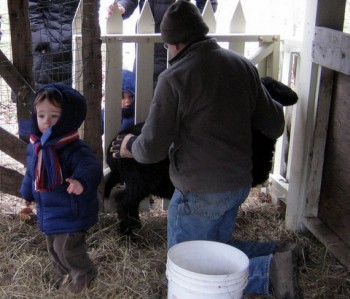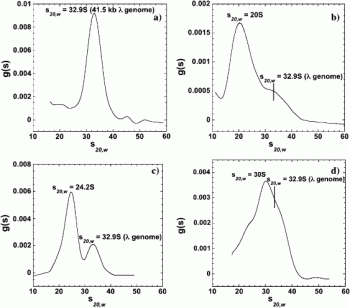AgriCulture bloggers Peter Davies and Mark Scherzer are the owners of Turkana Farms in Germantown, NY. This week Peter writes.

As you heard from Mark last week, we are all abuzz here about animal behavior. and seem to be on the qui vive, as The New York Times recently featured an article on how scientists are beginning to discover exactly where in the DNA of mice certain behaviors emanate. Apparently, animal behaviorists have discovered in studying two varieties of deer mice, one that digs a relatively short tunnel with no escape hole, and a variety that digs a much longer tunnel that features an escape hatch, where exactly in the DNA these behaviors are encoded. Significantly, even after generations of interbreeding and being raised in cages, these deer mice (once released into a natural situation with earth suitable for tunneling) immediately adopt the tunneling practices encoded in whichever strand of DNA they inherited. Mark’s recent post about the way ewes' bond to their lambs rang a bell with me. His observations caused me to remember the circumstances of Sultana’s birth a number of years ago. One early spring day around dusk, I was arriving to give the sheep their evening grain treat when I heard from out in the middle of the nearby field a soft, sad bleating, very much like the sound of a newborn baby. The herd itself was gathered at the barn expectantly awaiting their grain treat so it was odd to hear the sound of a lamb coming from the seemingly empty pasture. I quickly walked over towards what looked like a discarded plastic bag to find a tiny black lamb still encased in the placenta -- but no mother ewe to be seen. I carefully picked the tiny lamb up intending to get it to its mother as soon as possible, as it is in the first few minutes after birth that bonding takes place, and placed it on the ground in front of the assembled herd expecting a distressed ewe to rush forward. No one moved. I picked the lamb up and paraded it, rump first, in front of the noses of the ewes. No one would own up. They stood there uncharacteristically silent and still. The poor thing, I realized, had been abandoned. And I knew, to my dismay, that caring for it, our second bottle fed lamb, was up to us. And so for around six weeks the little one took up residence in a cardboard box in our mud room, handy to the kitchen. The next day we figured out by examining udders that the mother was probably Marina, one of our oldest ewes, since her udder was engorged with milk but she had no lamb. (And, corroborating our hunch, this turned out to be her last pregnancy).

But specifically the bell that rang for me was recalling that the lamb was not just abandoned but left encased in its placenta. I had previously understood that eating the placenta was a way for the ewe to get a protein boost. But learning that eating the placenta is also the first act of bonding made me see the situation in a different light. It was obvious that Marina had, for some reason, been prompted not to take that step. Why she did this we can only speculate but our subsequent experiences in raising the lamb, which we christened Sultana (left, with Mark and visiting friends), leads me to believe that it was because Marina had somehow detected that her lamb was defective. And, as it soon turned out, we learned that, unfortunately, Sultana was. Sultana’s first weeks and months were touch and go as she suffered from frequent, severe bouts of diarrhea. This meant that not only did we have to bottle feed her five or six times a day but we also had to flush down her throat periodically hefty doses of yogurt to stabilize her system. There were times when she was so weak, her diarrhea bouts so severe, and her daily care so overwhelming that I was tempted to let her go. But between bouts she had such a lively, adorable disposition as she pattered about the kitchen. So we kept her.

I am quite convinced that somewhere in Marina’s DNA was a mechanism that enabled her to recognize at some level and from the very beginning, possibly even before birth, that her lamb was not viable. I am certain that if she had kept her lamb and the normal course of nurturing had been followed Sultana would not have survived. In fact, to this day she continues to experience bouts of severe diarrhea, particularly in the spring when the flock shifts from hay to green grass, and we are still dosing her periodically with yogurt. Rejecting defective offspring seems very alien and cruel to us. But Nature’s way of dealing with defective creatures has, we must remember, the higher purpose of preserving the viability and longevity of the breed.
-1.jpg)
My new understanding of animal behavior has also caused me to rethink another experience we had with lamb rejection. Kybele, my favorite ewe, graced us with twin ramlings, which we named Osman and Orhan (left), after the first two sultans of the Ottoman dynasty. We were excited since these were our first twins but soon distressed because Kybele immediately rejected Orhan and would only suckle Osman. Still very much at the beginning of my understanding of sheep, I was convinced I could get Kybele to accept Orhan. I put him by her. She bonked him away. Repeatedly. I held him up to one of her teats. She tried to collapse on top of him. I pinned her in standing position up against the wall of the barn and tried to position Orhan near her udder. She again collapsed to the ground to prevent him. Despite the cold she would not even allow him to cuddle next to her. Something within her had absolutely closed towards him. And that was that. We, therefore, began a bottle feeding regimen to save Orhan but meanwhile called in our vet, Elaine Tucker, who diagnosed an udder infection, and determined that Kybele was not producing enough milk for two lambs. Apparently something somewhere in her DNA was triggered whereby she reacted: Osman would be saved, Orhan rejected. How the selection was made remains a mystery but what is possibly significant is that Osman was the larger, stronger, and more beautiful of the two. But if these were the factors what still remains a mystery is how she could have recognized these attributes. And where this very nonmaternal behavior came from. She had eaten his placenta and, therefore, begun the process of bonding, but at some point after that a switch seems to have been thrown. Despite medicating Kybele twice a day and slowly getting her back to health, we were disappointed to see that her decision, if we can characterize it as such, remained absolutely unchanged. Orhan was not hers — and so he became ours. And still is.









